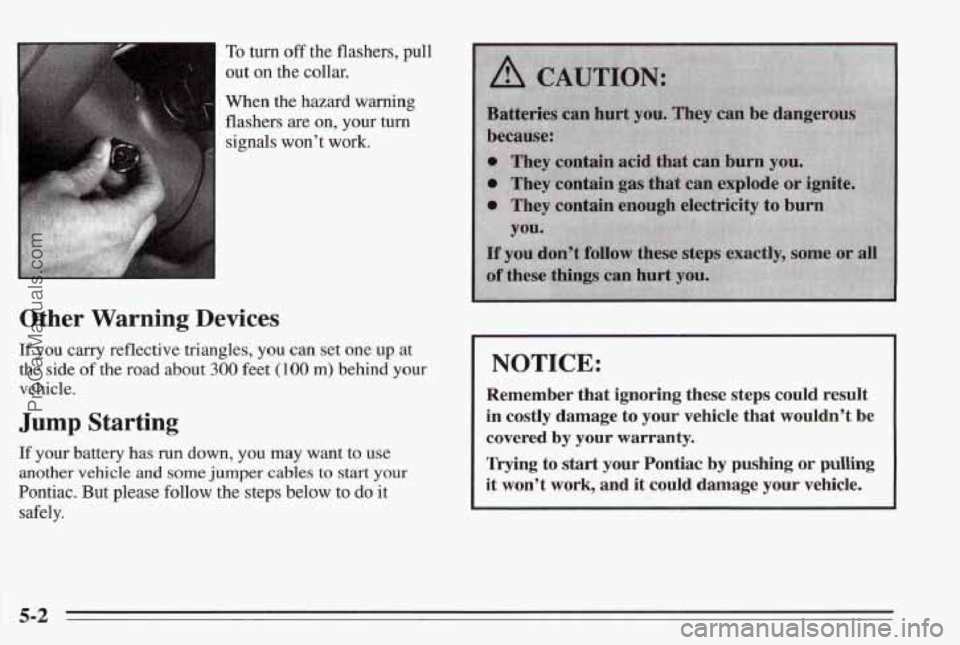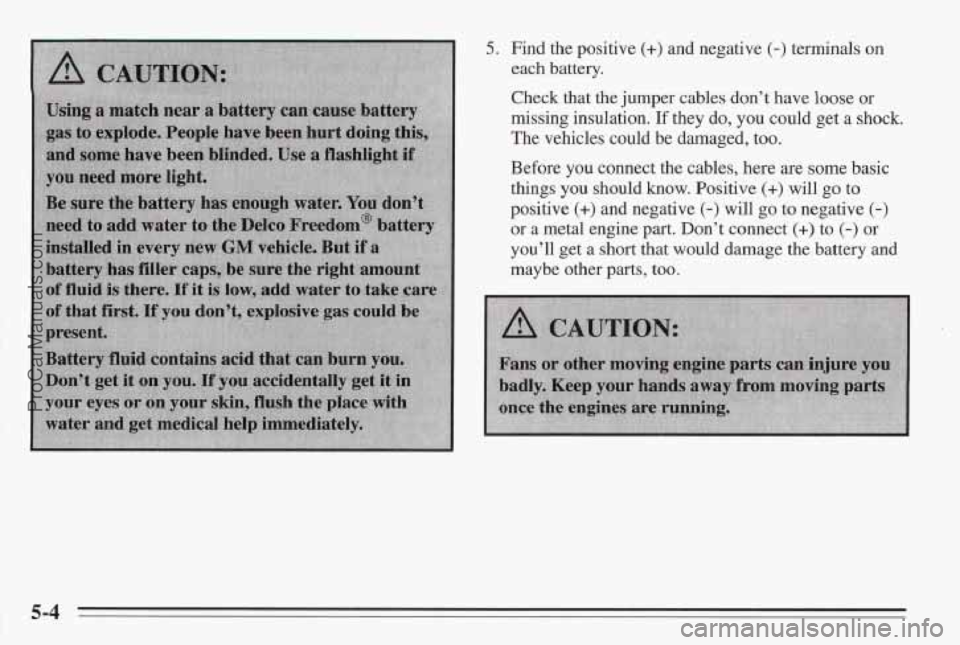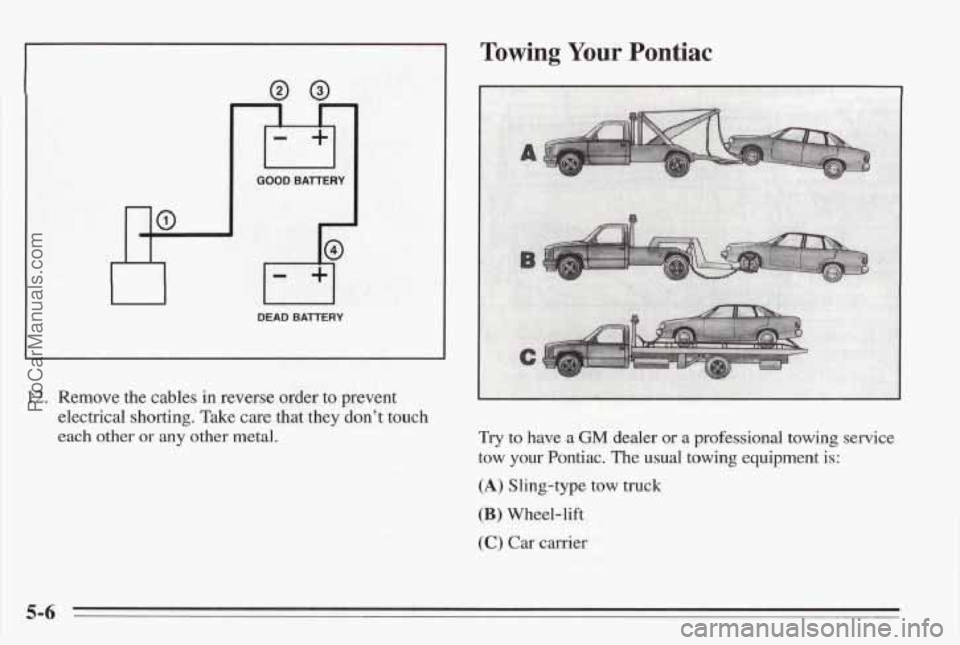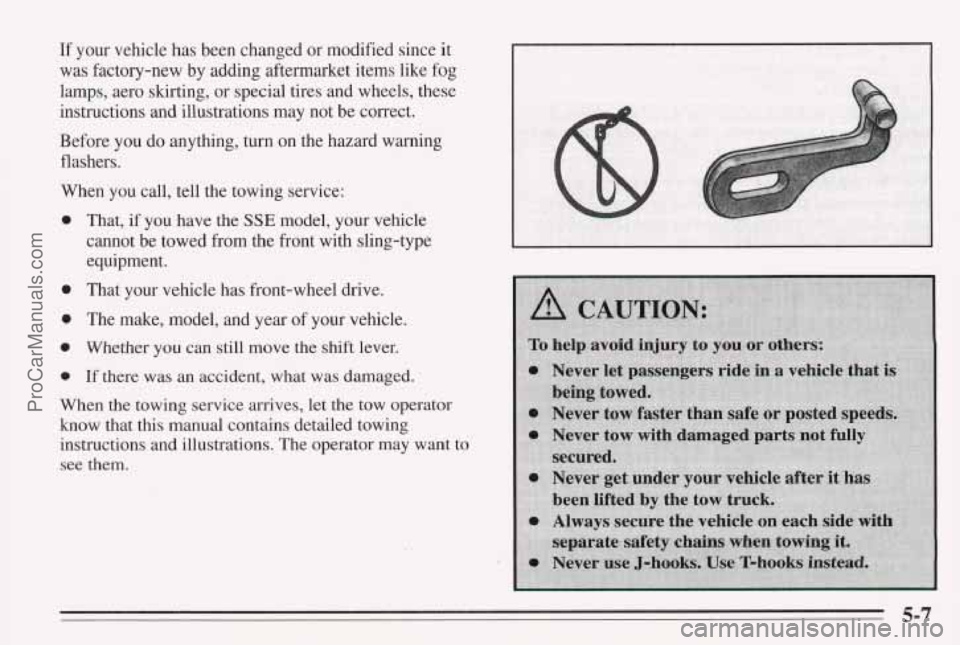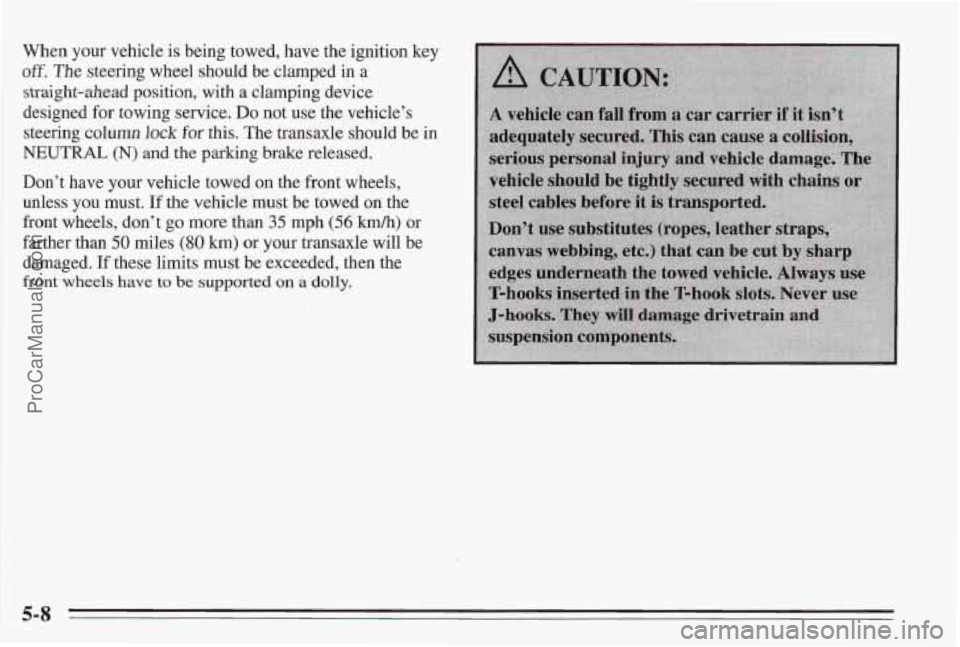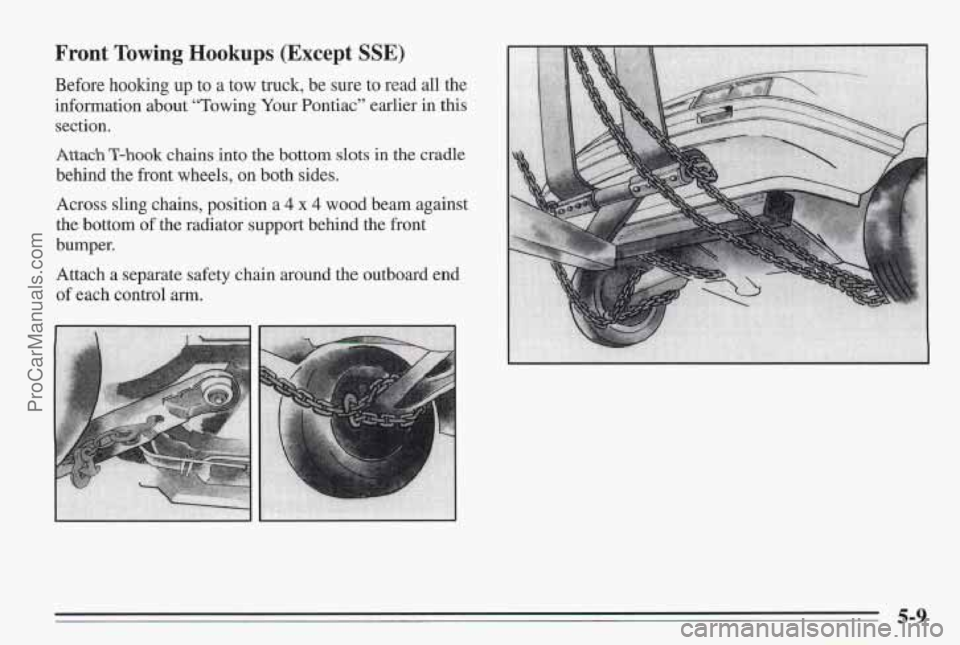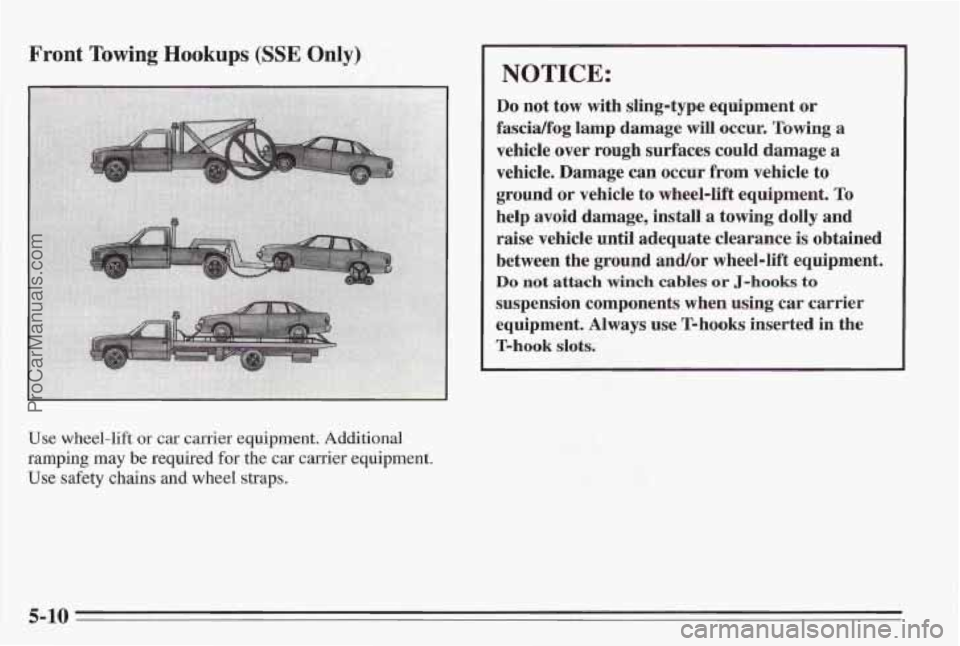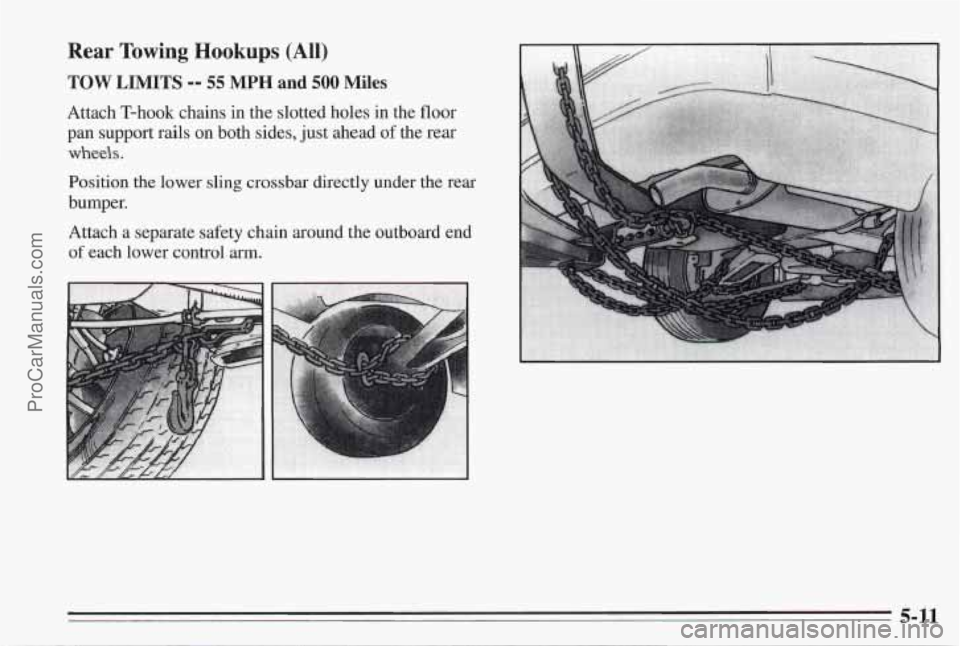PONTIAC BONNEVILLE 1995 Owners Manual
BONNEVILLE 1995
PONTIAC
PONTIAC
https://www.carmanualsonline.info/img/50/58377/w960_58377-0.png
PONTIAC BONNEVILLE 1995 Owners Manual
Trending: low beam, adding oil, check engine light, torque, spark plugs, child restraint, belt
Page 181 of 338
To turn off the flashers, pull
out on the collar.
When the hazard warning
flashers are on, your turn
signals won’t work.
Other Warning Devices
If you carry reflective triangles, you can set one up at
the side
of the road about 300 feet (100 m) behind your
vehicle.
Jump Starting
If your battery has run down, you may want to use
another vehicle and some jumper cables to start your
Pontiac. But please follow the steps below to do it
safely.
NOTICE:
Remember that ignoring these steps could result
in costly damage to your vehicle that wouldn’t
be
covered by your warranty.
ming to start your Pontiac by pushing or pulling
it won’t work, and it could damage your vehicle.
5-2
ProCarManuals.com
Page 182 of 338
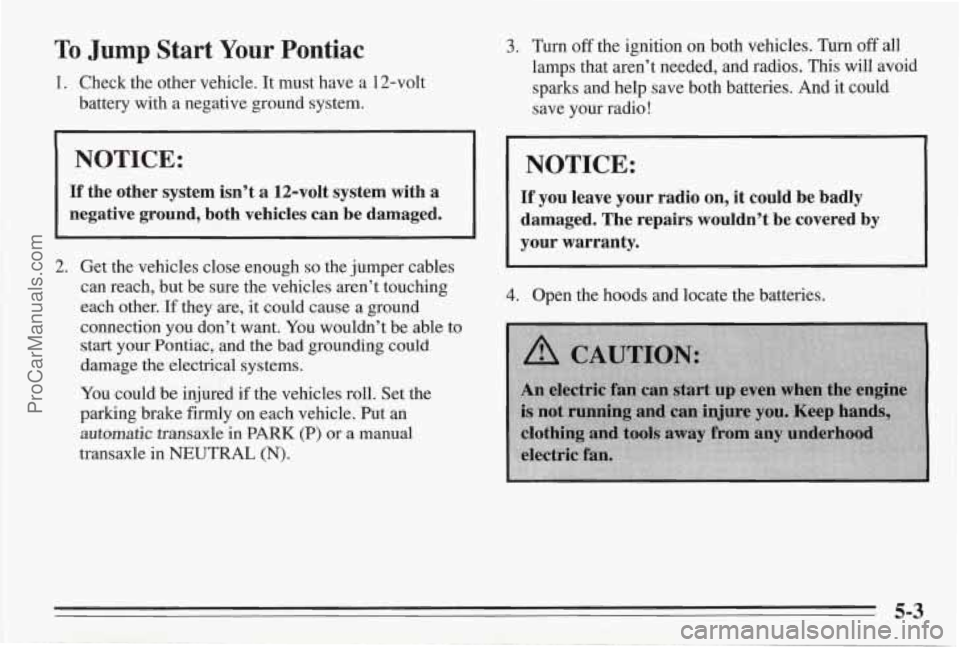
To Jump Start Your Pontiac
1. Check the other vehicle. It must have a 12-volt
battery with a negative ground system.
NOTICE:
If the other system isn’t a 12-volt system with a
negative ground, both vehicles can be damaged.
3. Turn off the ignition on both vehicles. Turn off all
lamps that aren’t needed, and radios. This will avoid
sparks and help save both batteries. And it could
save your radio!
NOTICE:
If you leave your radio on, it could be badly
damaged. The repairs wouldn’t be covered
by
your warranty.
2. Get the vehicles close enough so the jumper cables
can reach, but be sure the vehicles aren’t touching
each other.
If they are, it could cause a ground
connection
you don’t want. You wouldn’t be able to
start your Pontiac, and the bad grounding could
4. Open the hoods and locate the batteries.
the
damage the
electrical systems.
You could
be injured if the vehicles roll. Set
parking brake firmly on each vehicle. Put an
automatic transaxle
in PARK (P) or a manua
transaxle in
NEUTRAL (N).
1
5-3
ProCarManuals.com
Page 183 of 338
5. Find the positive (+) and negative (-) terminals on
each battery.
Check
that the jumper cables don’t have loose or
missing insulation.
If they do, you could get a shock.
The vehicles could be damaged, too.
Before
you connect the cables, here are some basic
things you should know. Positive (+) will go to
positive
(+) and negative (-) will go to negative (-)
or a metal engine part. Don’t connect (+) to (-) or
you’ll get a short that would damage the battery and
maybe other parts,
too.
5-4
ProCarManuals.com
Page 184 of 338
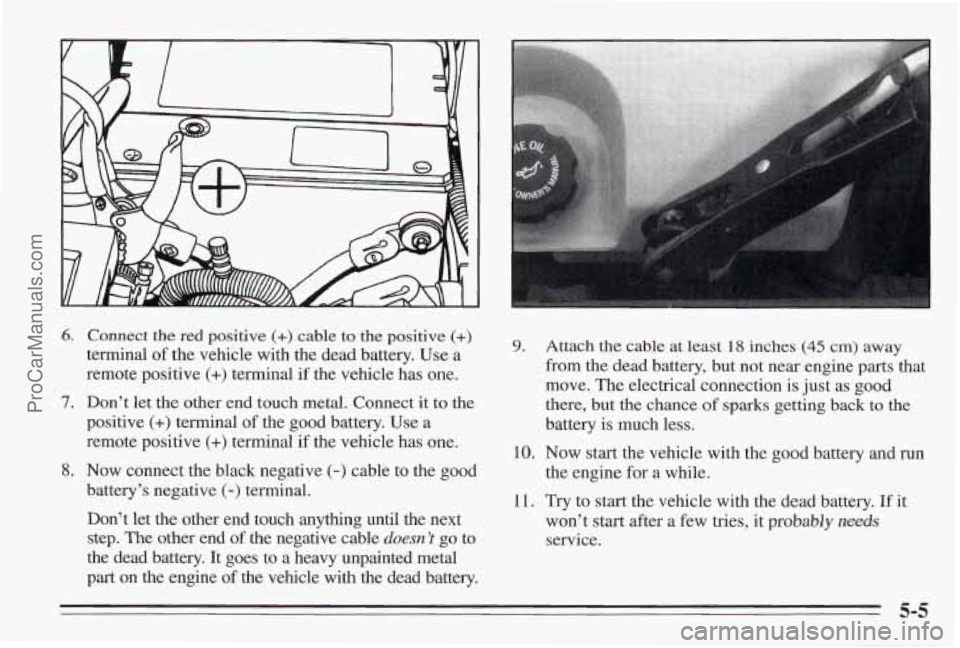
6. Connect the red positive (+) cable to the positive (+)
terminal of the vehicle with the dead battery. Use a
remote positive
(+) terminal if the vehicle has one.
7. Don’t let the other end t’ouch metal. Connect it to the
positive
(+) terminal of the good battery. Use a
remote positive
(+) terminal if the vehicle has one.
8. Now connect the black negative (-) cable to the good
battery’s negative
(-) terminal.
Don’t let the other end touch anything until the next
step.
The other end of the negative cable doesn’t go to
the dead battery. It goes to a heavy unpainted metal
part on the engine of the vehicle with the dead battery.
9. Attach the cable at least 18 inches (45 cm) away
from the dead battery, but not near engine parts that
move. The electrical connection
is just as good
there, but the chance
of sparks getting back to the
battery is much less.
10. Now start the vehicle with the good battery and run
the engine for a while.
11. Try to start the vehicle with the dead battery. If it
won’t start after a few tries, it probably
&s
service.
5-5
ProCarManuals.com
Page 185 of 338
c
Towing Your Pontiac
12. Remove the cables in reverse order to prevent
electrical shorting. Take
care that they don't touch
each other or any other metal.
DEAD BAlTERY
Try to have a GM dealer or a professional towing service
tow
your Pontiac. The usual towing equipment is:
(A) Sling-type tow truck
(B) Wheel-lift
(C) Car carrier
5-6
ProCarManuals.com
Page 186 of 338
If your vehicle has been changed or modified since it
was factory-new by adding aftermarket items like fog
lamps, aero skirting, or special tires and wheels, these
instructions and illustrations may not be correct.
Before you do anything, turn on the hazard warning
flashers.
When you call, tell the towing service:
0
0
0
0
0
That, if you have the SSE model, your vehicle
cannot be towed from the front with sling-type
equipment.
That your vehicle has front-wheel drive.
The make, model, and year
of your vehicle.
Whether
you can still move the shift lever.
If there was an accident, what was damaged.
When the towing service arrives, let the tow operator
know that this manual contains detailed towing
instructions and illustrations. The operator may want to
see them.
5-7
ProCarManuals.com
Page 187 of 338
When your vehicle is being towed, have the ignition key
off. The steering wheel should be clamped in a
straight-ahead position, with a clamping device
designed for towing service.
Do not use the vehicle’s
steering column
lock for this. The transaxle should be in
NEUTRAL (N) and the parking brake released.
Don’t have
your vehicle towed on the front wheels,
unless you must. If the vehicle must be towed on the
front wheels, don’t
go more than 35 mph (56 km/h) or
farther than
50 miles (80 km) or your transaxle will be
damaged.
If these limits must be exceeded, then the
front wheels have to be supported on a dolly.
ProCarManuals.com
Page 188 of 338
Front Towing Hookups (Except SSE)
Before hooking up to a tow truck, be sure to read all the
information about “Towing Your Pontiac” earlier in
this
section.
Attach T-hook chains into the bottom slots in the cradle
behind the front wheels, on both sides.
Across sling chains, position a
4 x 4 wood beam against
the bottom
of the radiator support behind the front
bumper.
Attach a separate safety chain around the outboard end
of each control arm.
ProCarManuals.com
Page 189 of 338
Front Towing Hookups (SSE Only)
Use wheel-lift or car carrier equipment. Additional
ramping may be required for the car carrier equipment.
Use safety chains and wheel straps.
NOTICE:
Do not tow with sling-type equipment or
fascidfog lamp damage
will occur. Towing a
vehicle over rough surfaces could damage
a
vehicle. Damage can occur from vehicle to
ground or vehicle to wheel-lift equipment. To
help avoid damage, install a towing dolly and
raise vehicle until adequate clearance is obtained
between the ground and/or wheel-lift equipment.
Do not attach winch cables or J-hooks to
suspension components when using car carrier
equipment. Always
use T-'hooks inserted in the
T-hook slots.
ProCarManuals.com
Page 190 of 338
Rear Towing Hookups (All)
TOW LIMITS -- 55 MPH and 500 Miles
Attach T-hook chains in the slotted holes in the floor
pan support rails on both sides, just ahead
of the rear
wheels.
Position the lower sling crossbar directly under the rear
bumper.
Attach a separate safety chain around the outboard end
of each lower control arm.
c-11
ProCarManuals.com
Trending: warning, heating, power steering, wiper blades, cooling, low oil pressure, manual transmission
